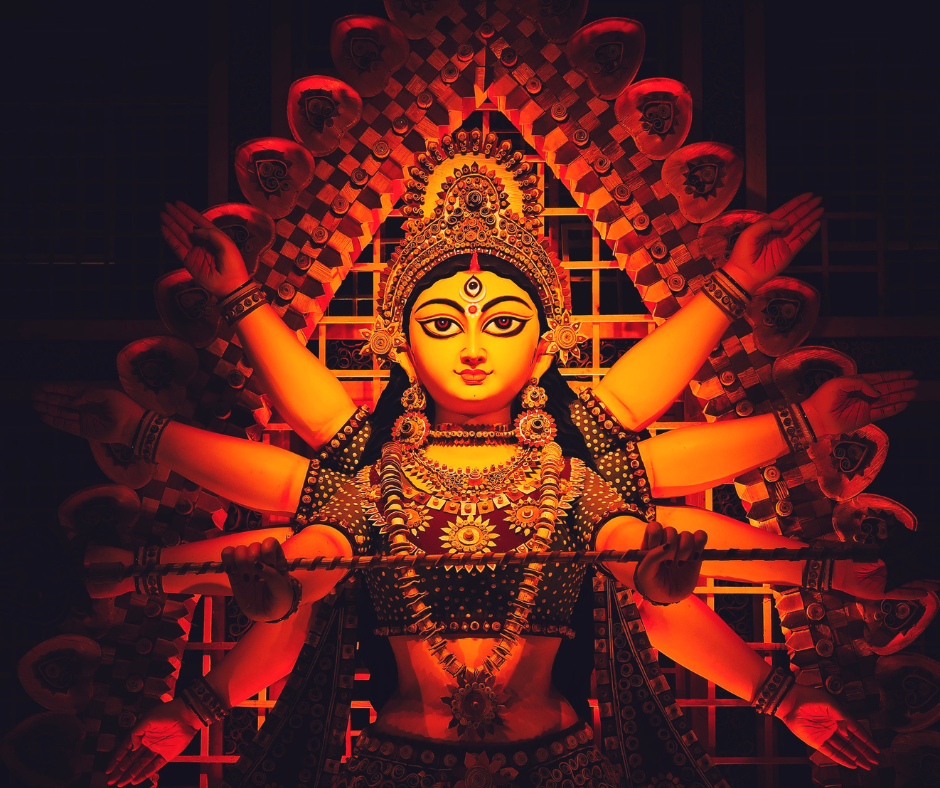“Navratri Aarti and The Sacred Nine Nights and the Cultural Essence of Garba “
Navratri is one of the most celebrated Hindu festivals, dedicated to the worship of the goddess Durga. It typically occurs in October (or late September), marking the beginning of the festive season in India. The word “Navratri” comes from the Sanskrit words “Nav” (meaning nine) and “Ratri” (meaning nights), symbolizing the nine nights and ten days during which the festival is celebrated.

Why We Celebrate Navratri
Navratri is a revered Hindu festival that celebrates the victory of the goddess Durga over the demon Mahishasura, symbolizing the triumph of good over evil. According to Hindu mythology, Mahishasura was a formidable demon whom no man or god could defeat. In response, the gods created Durga, a powerful goddess who battled Mahishasura for nine days and nights, finally defeating him on the tenth day, celebrated as Vijayadashami or Dussehra.
During Navratri, each day honors a different form of Durga. Devotees fast, pray, and engage in various religious rituals, seeking her blessings for health, wealth, and prosperity.
Navratri AARTI ( jai adhyashakti )
ay Adhya shakti Maa jay Adhya shakti
Akhand brahmand dipavya, padve pragatya Maa
Om jayo jayo Maa jagdambe….
Dritiya be swarup Shivshakti janu (2)
Brahma Ganapati gaau (2) har gaau har Maa…. Om jayo ….
Tritiya tran swarup tribhuvan ma betha (2)
Trayathaki Tarveni (2) tu Tarveni Maa…. Om jayo….
Chothe chatura Mahalaxmi Maa sachra char vya pyya (2)
Chaar bhuja choudisha (2) pragatya dakshin Maa… Om
jayo….
Panchami panch rushi panchmi gun padma (2)
Panch sahastra tya sohiye (2) Panche tatvo Maa. Om jayo….
Shashthi tu Narayani Mahisasur maryo (2)
Narnari na roope (2) vyapya saghde Maa…. Om jayo….
Sapta mi sapta patal sandhya Savitri (2)
Gau Ganga Gayatri (2) Gauri Geeta Maa…. Om jayo….
Ashthami ashth bhuja aayi ananda (2)
Sunivar munivar janamya (2) Dev daityo Maa…. Om jayo…
Navmi nav kul naag seve Nav Durga (2)
Navratri na poojan Shivratri na archan kidha har Brahma. Om
jayo….
Dashmi dash avtaar jay Vijyadashmi (2)
Rame Ram ramadya (2) Ravan rodyo Maa….Om jayo….
Ekadashi agiyarash katyayanika Maa (2)
Kaam Durga Kalika (2) Shyaama ne Raama…. Om jayo….
Baarse bara roop Bahuchari Ambe Maa (2)
Batuk bhairav sohiye kal bhairav sohiye taara chhe tuj
Maa…. Om jayo….
Terse tulja roop tame Taruni Maata (2)
Brahma Vishnu sada Shiv (2) gun tara gata…. Om jayo….
Chaudashe chuda roop Chandi Chamunda (2)
Bhhav bhakti kai aapo, chaturai kai aapo Sihwahani Maata….
Om jayo….
Pooname kumbh bharyo sambhadjo karuna (2)
Vashishtha deve wakhanya, Markand deve wakhanya gaaye shubh
kavita….
Om jayo…
Savant sole satavan solse baavis Maa (2)
Savant sole pragatya (2) reva ne tire Maa Ganga ne tire….
Om jayo…
Ekme ek swarup, antar nav dharso (2)
Bhola Bhavani ne bhajata (2) Bhavsagar tarso. Om jayo jayo
Maa jagdambe….
Trambavati nagari Maa Roopavati nagari (2)
Sol sahastra tya sohiye (2) Kshma karo Gauri Maa daya karo
Gauri…. Om
jayo….
Maa ni Chund-di laal gulal, sobha bahu sari (2)
Aangad kunkad nache, jai bahucharwali… Om jayo….
Shiv Shakti ni aarti je bhaave gashe (2)
Bhane Shivanand Swami (2) Sukh smapati thaashe har Kailashe
jase,
Maa amba dukh harse…. Om jayo….
Jay Adhya shakti Maa jay Adhya shakti
Akhand brahmand ni paavya, padve pragatya Maa
Om jayo jayo Maa jagdambe….
Kapuura Gauram Karunaa Vataaram
Sansaara Saaram Bhujagendra Haaram
Sadaa Vasantam Hridayaa Ravinde
Bhavam Bhavaanii Sahitam Namaami
The Importance of Garba
Garba, a traditional dance form from Gujarat, plays a central role in Navratri celebrations. Dancers perform Garba in a circle around an earthen lamp or a statue of Durga, symbolizing the cycle of life and the victory of light over darkness.
Spiritual Symbolism: The circular dance reflects the cycles of time, life, and death, with participants expressing their devotion to the goddess through rhythmic, communal movements.
Cultural Identity: Garba is more than just a dance; it’s a vibrant celebration of Gujarati culture that brings communities together in joyful expressions through colorful costumes, music, and dance.
Social Bonding: Garba unites people, fostering a sense of belonging and community among participants of all ages and backgrounds.
When and Where Navratri Takes Place
Navratri occurs in the Hindu month of Ashwin (September-October), following the monsoon season. While celebrated across India, the most elaborate and vibrant festivities take place in:
- Gujarat: The heart of Navratri celebrations, featuring grand Garba nights, cultural events, and community prayers.
- West Bengal: Known for Durga Puja, which coincides with Navratri and involves worshipping elaborately crafted idols of Durga.
- North India: Celebrations include fasting, prayers, and Ramlila performances, culminating in Dussehra.
- South India: Marked as Golu, with artistic displays of dolls and figurines representing gods, goddesses, and mythological scenes.
Navratri is not just a religious festival but a celebration of culture, music, dance, and the enduring spirit of community and devotion.
FOR RANGOLI VISIT PINTEREST